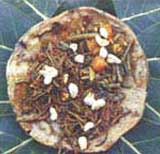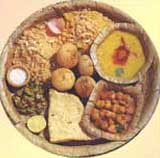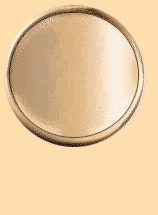Each
region in India has its own traditional dishes and specialities.
In the royal kitchens of Rajasthan, as well as most other
states, food is a very serious business and raised to the
level of an art- form. Rajasthani cooking was influenced by
the war -like lifestyle of its inhabitants and the availability
of ingrediants in this region.
Food that
could last for several days and could be eaten without heating
was preferred, more out of necessity than choice. Scarcity
of water, fresh green vegetables have all had their effect
on the cooking. In the desert belt of Jaisalmer, Barmer
and Bikaner, cooks use the minimum of water and prefer,
instead, to use more milk, buttermilk and clarified butter.
|
|
 Ker-Sangri
on Bajara Roti
Ker-Sangri
on Bajara Roti |
Dried
lentils, beans from indegenous plants like sangri, ker, etc
are liberally used. Gram flour is a major ingrediant here
and is used to make some of the delicacies like khata, gatta
ki sabzi, pakodi, powdered lentils are used for mangodi, papad.
The daily food in Rajasthan typically comprises unleavened
bread, made of wheat, barley, millet or maize.
A
soup of legumes flavored with red chili peppers, yogurt or
milk and sometimes a vegetable such as okra, jackfruit, eggplant,
mustard or fenugreek leaf. The wealthy can afford to eat meat
regularly, but many abstain for religious reasons. Though
the Rajasthani kitchen was able to create much from little,
it had also to cater to different communities with their own
ritual observances.
|
|
The
Rajput warrior, for example, was not averse to shikar, killing
game to put in his pot at night.The Vaishnavs, followers of
Krishna, were vegetarian, and strictly so, as were the Bishnois,
a community known for their passion to conserve both animal
and plant life.Even amoung Rajputs, there were enough royal
kitchens where nothing other than vegetarian meals were cooked.
The
Marwaris , of course, were vegetarian too, but their cuisine,
though not too different from the Rajputs, was richer in its
method of preparation. And then there were the Jains too,
who were not only vegetarians, but who would not eat after
sundown, and whose food had to be devoid of garlic and onions
which were, otherwise, important ingredients in the Rajasthani
pot.
|
 Rajasthani
Dal-Bati-Churma
Rajasthani
Dal-Bati-Churma |
 |
Mughal inspired Dishes
- The Mughals influenced
the eating habits of the Rajput courts. From the simple grilled
meats served on leaves, the royal kitchen introduced elaborate
curries, kebabs and pulao's(rice prepared with clarified butter,
spices meat and vegetables) served on silver platters.
|
|
Chapatti Making -
The chapatti is a flat, unleavened bread which serves almost
as a spoon, for it is used as a scoop to transfer food to
the mouth. It complements both the texture and flavor of the
food it scoops up, absorbing runny sauces, balancing strong
flavors and smoothness.
|
 |
Frying
Puris - Puris are delicious, fried
wheat bubbles which have varied uses; as snacks, scoops for food
and as a complement to hot spices. Family members typically sit
on the floor and are served piping hot food by the lady of the houses.
 |
Khud
khargosh - Khud Khasrgosh
(Hare or rabbit meat cooked in a pit) is a Rajput specialty
during summer, when the hare is lean. The hare is skinned
and stuffed with spices, wrapped in dough and finally in layers
of mud-soaked cloth. The ambrosial result is meat perfectly
blended with the spices and dough.
|
|
The
Indian Kitchen - The simple
Indian Kitchen has a brick-and-mud fireplace. Food is usually
cooked over a wood or charcoal fire,in clay,brass,or copper
utensils.
|
 |
Lassi
-Natural yogurt is churned to remove the
butter content for the making of Lassi or buttermilk a cooling summer
beverage.
 |
Desert Cooking -
Very little produce grows in the desert. Daily food mainly
comprises of daal-bati (cooked lentils and roasted balls of
dough), accompanied by a variety of dried or pickled berries
cooked in different ways.
|
Recipe for
Sula :
In Rajput cuisine,
sula refer to tender morsels of meat, the most prized being wild
boar spare ribs(bhanslas), marinated in a mixture of dry yogurt,
browned onions, garlic, ginger, coriander, red chilli, and kachri,
a small pod which tenderizes meat and lends a particular sharp-sour
flaver to many dishes. The marinated meat is smoked, spitted on
skewers, and grilled over hot coals. Sulas are made of chicken,
pheasant, mutton, or fish.
Ingredients for
Sula.
2lb lamb leg(mutton
boneless), salt to taste, 1 oz malt vinegar, 3/4 oz ginger and garlic
paste, 17 oz curd, 3/4 oz red chilli paste, 2 oz mustard oil, 2
oz pineapple (raw) juice , 2 oz butter, 2 lemons, 1/2 oz garam masala.
1. Fillet
lamb leg and cut into thin one-inch strips, sprinkle salt and marinate
with half of malt vinegar.Put aside for two hours.
2. Mix ginger
and garlic paste, red chilli paste, salt, garam masala, mustard
oil, pineapple juice, and the rest of malt vinegar with the curd(curd
has to be hung in muslin cloth for two hours to obtain the solid
coagulated substance, allowing the liquid to drain). Marinate mutton
pieces in mixture and keep in the refrigerator for at least eight
hours
3. Skewer
mutton pieces . Allow eight to ten pieces per skewer.
4. Place skewered
mutton in a moderately hot charcoal clay oven. After seven to eight
minutes, turn over the skewer so as to ensure uniform cooking on
both sides. Cook for another two or three minutes cooking.
|







